Click Here for Tenkara Expert Guide Article 1
Click Here for Tenkara Expert Guide Article 2
Click Here for Tenkara Expert Guide Article 4
Tenkara Lines
The casting line used in tenkara is one of the most important keys to success. No joke. You can make your life super hard – or very easy – depending on what option you choose and what you ask your rig to do for you. Not sure what’s the best line for you? Don’t worry, Discover Tenkara has your back in Part 3 of “Bro, do you even Tenkara?”…
Here we explain how you can find the right tenkara line for your own personal needs….because:
- Further down this article you’ll find a table explaining those mysterious Japanese line rating numbers as well as showing you exactly how to choose your line like a boss.
- You’ll also find out the strengths and weaknesses of all the options on the market right now – this is your one-stop-shop information source.
- Basically – by the end of this article – you’ll be a tenkara line guru; so make sure your friends know it by Sharing it using the nifty social media buttons provided.
Read on to find out if you agree it deserves to be shared…
Tenkara Lines are not all created equally
Before we get going – I KNOW that the line needs to work well with a particular rod – but we’ll get to that in a different piece. For now, let’s keep our focus narrow and start with only the line. AND ONE MORE THING; YOUR TENKARA GURU ACCREDITATION CARD WILL BE TORN UP IF YOU CALL ANY OF THESE TENKARA CASTING LINES A “LEADER”…MMKAY? You could win it back by knowing that the combined unit of casting line AND tippet when tied together is known as the “shikake” in Japan – and that’s where you get the term “shikake maki” (“line-winder”) for the spools used to hold tenkara rigs…but enough of that…
Here’s the shocking thing for some folks; the original tenkara lines and the very first “western” tenkara lines were made of exactly the same material…Horsehair. Turns out there’s a few good reasons for that.
Traditional Tenkara Lines: Hand-twisted Horsehair
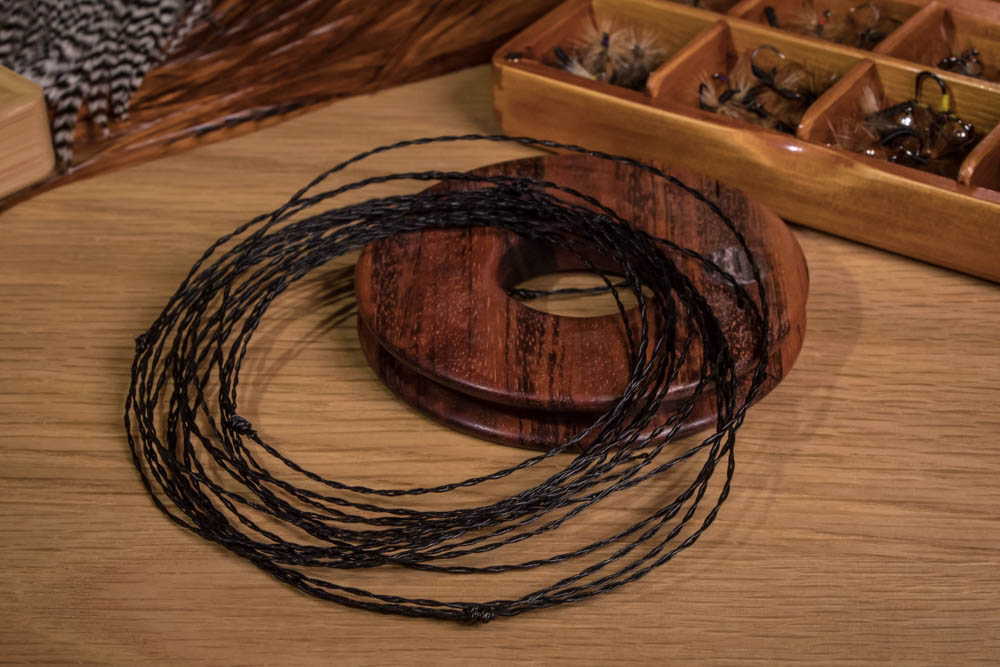
When twisted together these natural fibres have some great properties for a line that can be cast under its own momentum – WITHOUT the need for a separate casting weight attached to the line.
In other words – a fly line.
The weight, flexibility and strength (once furled together) make it a really good material for this job. Depending on the number of fibres you twist together – and how the number of fibres change as you move from the rod tip down towards the fly – you can control the taper and turnover of horsehair tenkara lines. That’s worth remembering when you realise that modern fly lines are impossible to make without specialised machinery (and probably some complex chemistry) being involved at some point.
Even silk fly lines need some complex apparatus before you can manufacture them. So the fact is, in our modern hi-tech world, you still only need your fingers and some strands of horse’s tail to make an effective fly line. That’s pretty amazing right?
Lines made from horse-tail even have characteristics that mean some of today’s remaining professional tenkara anglers still prefer them to the more common space age materials. That can even be true when those anglers use graphite rods instead of the traditional bamboo.
But why would anyone choose horsehair over fluorocarbon or some other modern fibre?
Well, Yamada-san (a professional tenkara angler, inn-owner and sometime professional bear-hunter) still uses his own hand-made horsehair lines with some pretty expensive Gamakatsu graphite rods. As well as the fact that his (level!) horsehair lines are absolutely beautifully made – the fibres have qualities that let Yamada-san change the casting weight of his line from one cast to the next. That might seem like magic, but it comes from the way that the twisted fibres take on water – and then easily shed that water with a firm, snappy cast.
So if Yamada san needs a lighter line with less “Drape Otsuri”, he makes sure that his line never touches the water and it stays dry and fairly light…On the other hand, if he needs a heavier line to cut through the wind and reach a greater distance – he will let it lay on the surface of the river to soak up the right amount of water to gain the weight he needs. Then if he feels he needs to go back to a lighter line, some quick drying casts in the air kick the water out of the woven fibres in a fine spray. A variable-weight line that you can easily control. Clever.
Although the most common colour for horsehair lines in Japan is a dark brown (brilliant for stealth by the way!), Yamada san now and again likes to make a pale blonde/white line when he can get the right coloured horsetail. He’ll use this when he needs a more visible line to help with tracking the drift of his kebari (fly) or even detecting when a fish has grabbed a sunken fly. However, he can’t often get hold of pale horsehair (I recently sent him a gift package of some that I’d found for him – so I hope it is up to his high standards!). Interestingly, in traditional western fishing, pale horsetail hair has the reputation of being stronger than dark horsehair. I’d be interested to see some comparisons of Japanese (dark) horse-tail fibres to western pale ones.
Of course, the original Japanese anglers would make their tenkara lines from whatever materials were available to them.
What’s the downside?
Because of its mass when furled – and because it is often tapered from butt to tip – the old familiar Drape Otsuri tends to come into play. That can mean that you need to lay some of the casting line onto the water in order to get the range that you need. If you’ve been following my email lessons for a while – you will probably remember “The Triangle of Awesome Fly Fishing Advantage” (diagram below as a reminder).
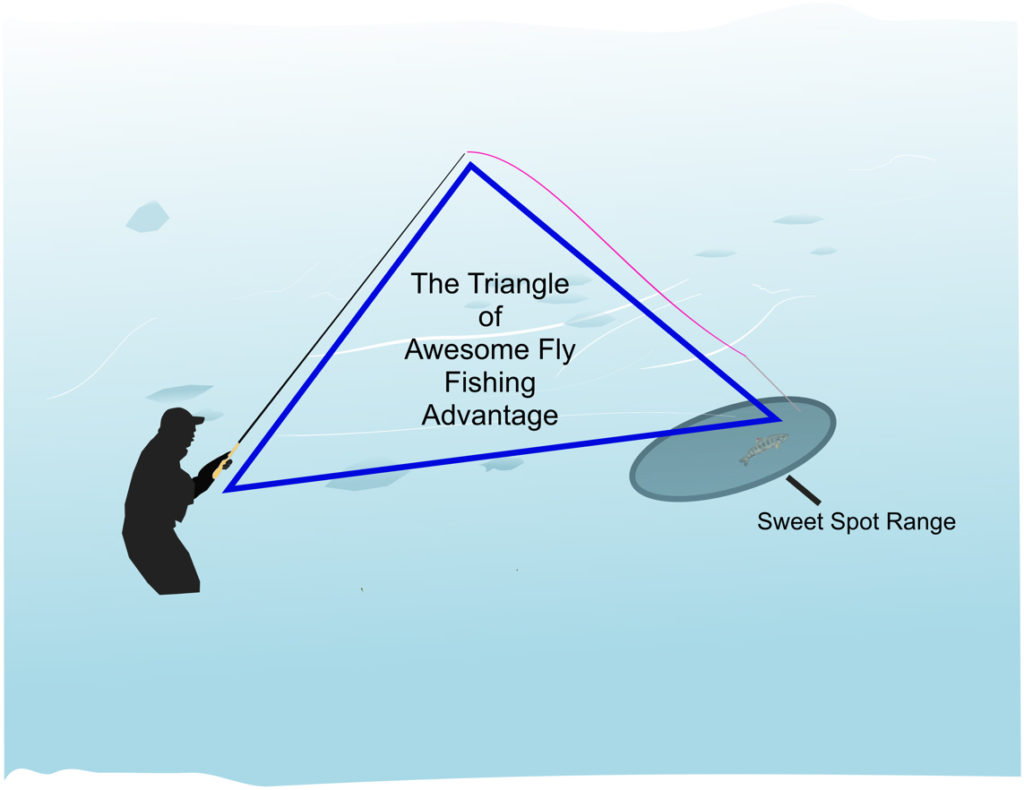
This applies in absolutely the same way to French Leader fishing as it does to tenkara. Whenever you fish with a high rod tip, the less “drape otsuri” effect that you have the better you can present your fly at range. This advantage is usually massively increased when you are able to do a “fly first/fly only” cast – where the only thing to land on the water is your fly…
BUT – in a special set of conditions some anglers (like Hirata-san from Shiro-Tori in Gifu prefecture) actually SOMETIMES like to have the tip of the casting line make a small splash when it lands. When done at the right time, it can be a way of drawing a fish’s attention to the fly (note that this is really difficult to get right and it is so easy to end up spooking fish).
Another consideration is that horsehair lines usually need a fairly stiff rod to perform to their best. For professional anglers, that isn’t too much of a problem because they want to haul the fish to hand as fast as possible. The rod and line are very much treated as tools of work.
But many people love the way they cast. They are a great way of experiencing the tradition of all fly fishing (not only tenkara) and there is a lot of romance to the idea of using hand-made lines that carry such a lot of our fly fishing history.
Horse Hair Tenkara Lines Summary
FOR:
- Can be made from scratch and fine-tuned to your own personal preferences without any technology beyond a pair of scissors
- Drab and “non-spooky” for stealth
- Easy to control the casting weight by controlling how much water they hold
- Strong sense of history and tradition when you fish with one
AGAINST:
- You need a source of raw material
- You need a bit of practice to twist the fibres together with your fingers
- Drape Otsuri is more evident compared to level fluorocarbon
Furled Nylon Tenkara lines
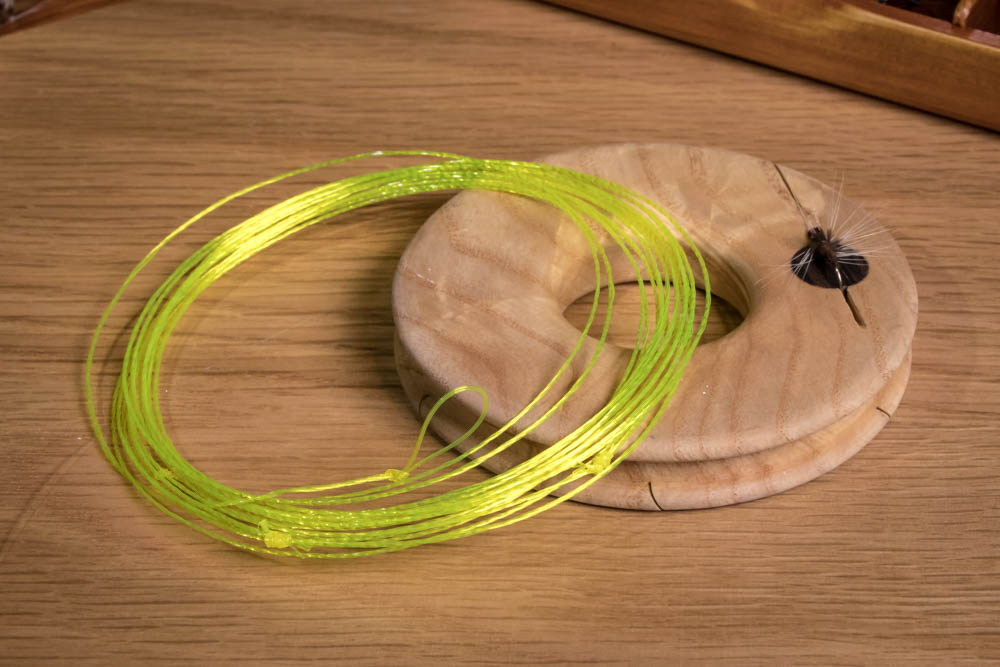
Yuzo Sebata san, Shouichi Saito san and others make these from regular nylon fishing line. Lines of greater density can also be made by swapping nylon line for fluorocarbon. They are generally tapered and with a surprising similarity in feel and weight to horsehair lines. Just like those original lines, these can be made by hand (and you can even use an almost identical method to furl a nylon line with your fingers).
Sebata-san uses an electric drill to spin together his lengths of line to make the long, quite weighty, tenkara lines that he prefers (his overall line and tippet length is usually around 7 metres long, fished from a 4.5-metre rod). Saitou-san tends to prefer shorter lines – and he matches them to the “Suzutake” bamboo rods that he makes (which are generally relatively short – at around 3 metres long).
Although nylon doesn’t absorb water to quite the same degree as horsehair, the furl and the ability to shed water when false cast make it very much like using horsehair. Again, these lines will usually benefit from bamboo or quite stiff graphite rods to make the most of their mass and turnover properties (as well as the hook-set when you need to overcome the mass of the line and the grip of the water). And, just like horsehair, furled nylon has a fair degree of Drape Otsuri and you often need to lay the tip of the casting line onto the water to fish at the range you want with your kebari (fly).
The summary for these lines would look almost identical to the “For and Against” listed for Horsehair lines…BUT nylon is a bit easier to source than horsehair, doesn’t absorb quite as much water and it is definitely available in more colours…
The similarity in feel (and also because some old-time tenkara anglers still make these by hand) does make them another natural pairing to a traditional bamboo rod – or for anyone who wants to have that “traditional-feeling tenkara” experience.
Furled Nylon Tenkara Lines Summary
See Horsehair line summary (and then note availability of different colours in nylon 🙂 )…
Factory-tapered nylon tenkara lines
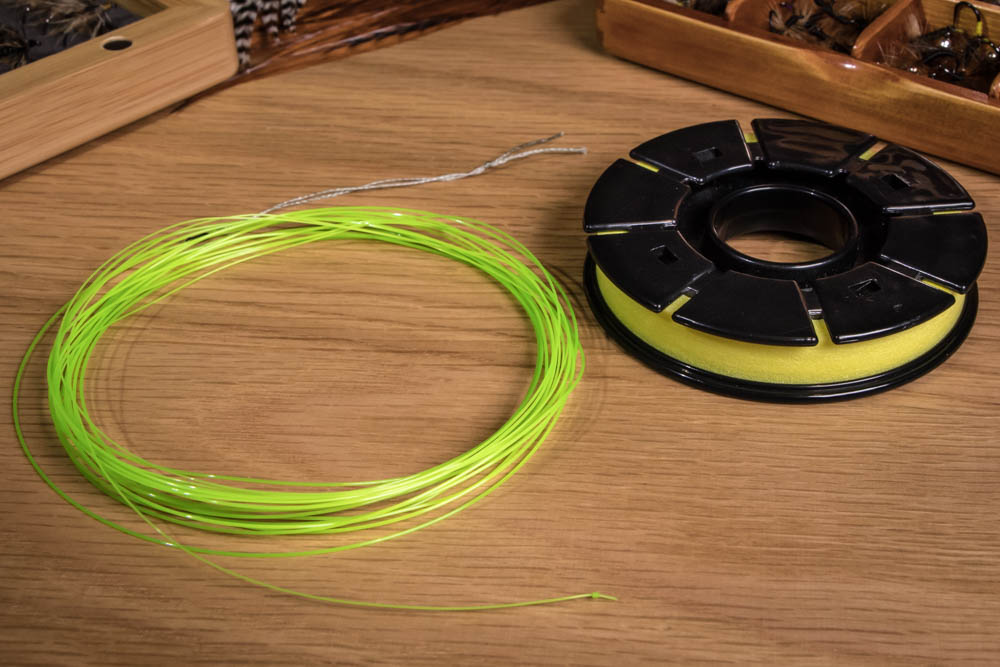
These lines are custom made in a factory using coloured nylon with carefully controlled texture and stiffness. They are extruded out as a single filament (NOT braided or furled), and their diameter varies throughout their length according to a carefully-designed taper.
They are NOT the same beast as a factory-tapered leader for trout fishing (or shock-leader for sea fishing). These lines cast WAY better than either of those things on a tenkara rod.
However, because they are thicker at the butt end – they “want” to hang down from the rod tip (our friend Drape Otsuri again). The lightness of nylon and the long, thin tip of the tapered line does make it land quite gently on the water. It is also easy to make it float with a light application of floatant.
These qualities make them good for fishing in a “western” fly fishing style – and the ones made by Fujino cast very well. So for times when you absolutely have to lay line on the water (for example if tree branches force you to fish with a low rod-tip position), they work really well. Also, for people who mostly use tenkara rods as a packable way of fishing western fly fishing methods – these lines fill that role very well too. But when it comes to “line off the water” tactics, they are not the best option.
Oh – also, all of the best ones of this type of line are made by just one, small family-run company in Japan; Fujino.
Factory-Tapered Nylon Tenkara Lines Summary
FOR:
- Excellent turnover
- Gentle landing
- Easy to float when greased
AGAINST:
- Not good for holding line off the water
- Not amazing for fishing in windy conditions
“Tenkara lines” made from Furled Fly Tying Thread
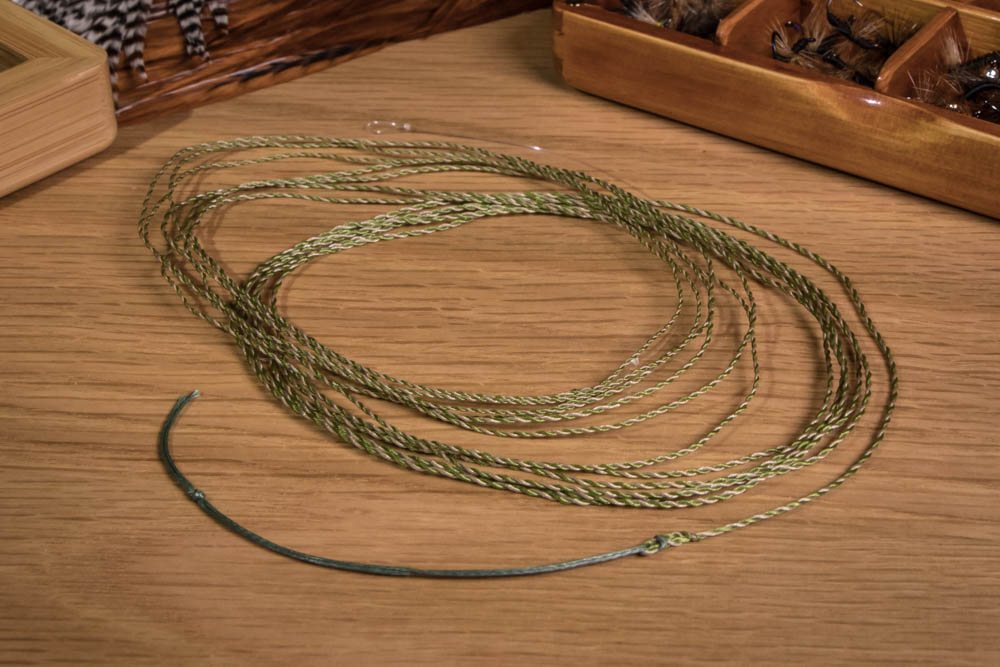
These are basically longer versions of the tapered, furled leaders that are often used with western silk fly-lines. Because of this design, the lines can be made to turn over almost regardless of how well you cast them (they are quite forgiving of casting technique). BUT – they have a serious drawback; Basically they have all of the exaggerated drape otsuri restrictions of tapered lines but none of the long-term floatability. PLUS they absorb water like a sponge (they take on much, much more water than horsehair or nylon furled lines).
It also seems that the use of fly tying thread and similar materials is likely to be a western development put in place by relatively inexperienced tenkara anglers as the method was being introduced overseas.
These lines are also highly prone to becoming impossibly tangled when they rebound towards you after pulling them out of a snag.
That combination of restrictions basically means that there is always a better option for your tenkara line. For instance, the factory-tapered nylon lines cast and turn over even better than tying-thread furls – and yet they are much easier to float (and they don’t suck up water with anything like the same thirst). In the same way, it is impossible to modify the weight of thread furls as Yamada-san does with horse-hair lines. Thread furls take on too much water – and they hang onto it more stubbornly.
Furled Tying Thread Tenkara Lines Summary
FOR:
- Forgiving of poor tenkara casting technique
- Can be fun to make for yourself
AGAINST:
- All of the negatives listed for other lines – plus they soak up water like a sponge (even when treated with floatant or water-repellant).
- Prone to tangling
Braided Tenkara Lines
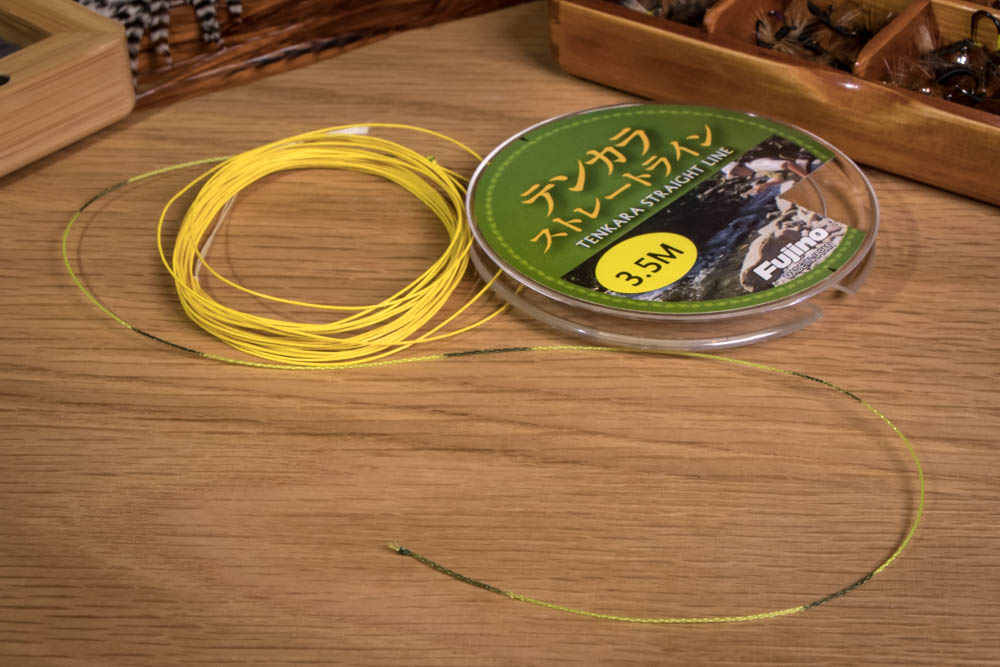
These are generally made from fine nylon that is braided together by machine and can be extremely variable in their casting performance – depending on how well the manufacturer understands tenkara. Most commonly, these are designed with a taper – presumably to aid turnover.
An interesting modification to those tapered braids is the line Dr Ishigaki has brought to market with Fujino – known as “Fujino Straight Line” (pictured above). It is designed as a hassle free (no coil memory) line with a built-in stripy indicator section at the tip. Because it is braid, there is almost zero stretch and it does turn over well when cast. However, it does not cope too well with wind and coil memory need not be a problem with other lines anyway. Again, drape otsuri is greater with this line than with regular “level lines” (as we’ll see below).
As with other thin, level braids though it can be a good option for “braid nymphing” tactics using heavily weighted flies in fast rivers on rod and reel setups – the lack of stretch transmits all taps and bumps very well to the hand of the angler. That merits another completely separate article though.
Summary
FOR:
- Generally zero coil memory and almost no stretch
AGAINST:
- Variable casting performance, more susceptible to drape otsuri than alternatives
Titanium (wire) “Tenkara lines”
Marketed as a solution to windy conditions, these lines are a sledgehammer to crack a walnut. The idea being that they are so dense that they will cut through the wind and make it basically irrelevant which way the wind is blowing. Here’s the thing, a huge part of tenkara is using the wind to slow down, speed up, pause or otherwise control what your fly is doing AFTER you have completed your cast. That includes controlling depth as well as general movement of your fly/kebari.
For me and JP, this is a bit too close to the old fashioned Victorian philosophy of Man Must Dominate Nature. Yes they are possible to use, but you sacrifice so much of the experience that I don’t think it’s worth it…I mean, you already know what I’m going to say about drape…
Wire Tenkara Lines Summary
My advice is to Steer clear and if you need tips to beat the wind – you can get a Free PDF showing you how to beat the wind with your first lesson in our (also free) email tutorial series.
Click here to pick your location and sign up.
Level Fluorocarbon Tenkara Lines
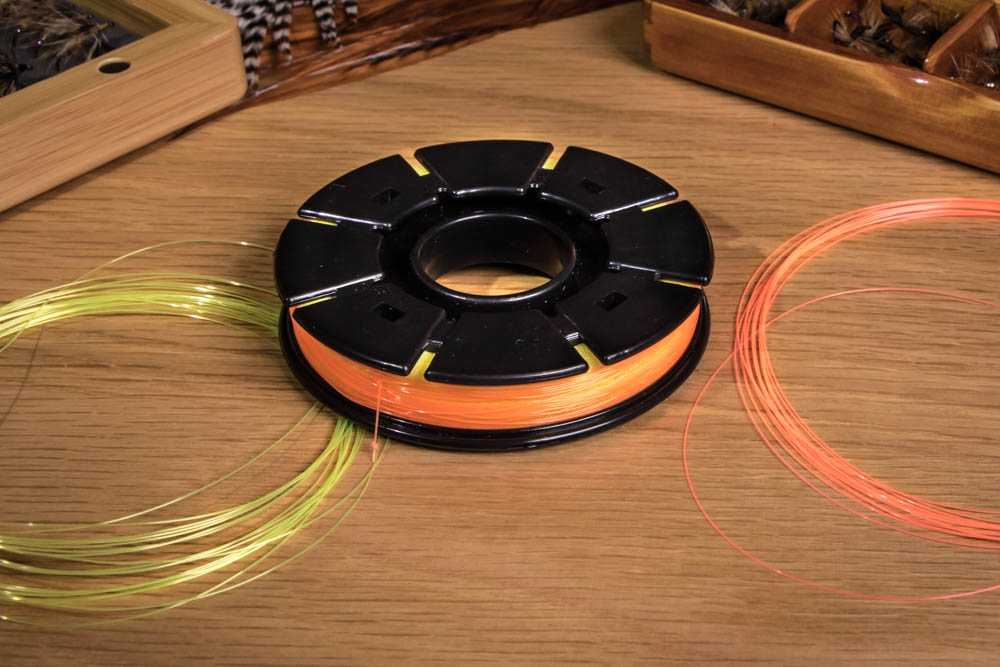
Lines made of 100% fluorocarbon and coloured specifically for use in tenkara (adding colour to fluorocarbon is much more difficult than with nylon) can create some truly excellent lines. The density of fluorocarbon is around 1.6 to 1.8 x that of nylon. The variation depends on the exact composition of either the nylon or the fluorocarbon. Regardless, that “dense but not too dense” character of fluorocarbon can produce excellent casting performance.
Laser accuracy is possible with a bit of practice, plus fluorocarbon can be used in very fine diameters that can be held off the water at range. In those fine diameters, the lack of a thick butt section means that it is possible to maintain a much shallower curve between rod tip and fly. Halleluja.
Look out for specialist tips from badboy “Tenkara Rockabilly” Fujiwara-san in Season 2 of Tenkara in Focus for his special rig tweaks for further extending reach with fluorocarbon lines – while combating drape otsuri…
At the other end of the scale, larger diameter fluorocarbon offers different advantages. The high density means that it is capable of casting large, wind-resistant kebari (flies) on long lines (eight to ten metres long plus two metres of tippet). Those heavier lines (rated in the #4, #4.5 and #5 range) will give you all the wind-beating performance that you need to fish right into the teeth of a strong wind (as long as you lay that casting line on the water as soon as it lands). Even in that “combative” approach to wind, you’ll find what you need in a fluorocarbon line without needing to reach for the titanium wire.
When manufactured in the small batches used by the tenkara community, it is possible to produce fluorocarbon in a range of colours to aid visibility. Do be slightly wary of some of the sea fishing fluorocarbons like BMS sniper that are marketed as tenkara lines, their visibility (and sometimes castability) often isn’t quite as good as the dedicated lines. The texture/stiffness of each line makes a big difference to how well it will cast. The best lines have a distinctive “swish” sound when cast with the most gentle and smooth action you can manage. They are slightly wiry but still with some softness.
Overall, fluorocarbon level line offers the highest performance across the greatest range of conditions; and that is the reason for its passionate band of followers in Japan and beyond.
Now we’re on the subject of level fluorocarbon, to choose your level lines like a boss, it helps to have an idea where the Japanese numbering system for fishing lines comes from. Note, it has absolutely nothing to do with the AFTM system!
Japanese Numbering System for Tenkara Lines
David Walker did probably the most complete English-language explanation of how the Japanese line numbering system works – based on his typical careful attention to detail. Basically, as David explains, you need to know that when you cut through a piece of standard #1 line on the Japanese scale…the AREA of its cross section is 0.0213825 mm2. This is the benchmark area for “number one” line – and all other line numbers are related to it in direct proportion.
Once you know that, then it gets easier to understand that #2 line just has twice that cross sectional area. Also, because the cross section is a circle, with a little bit of high-school maths (involving pi), you can work out the diameter for each line as well.
But because I love you, I can save you the effort of doing those sums with the table below:
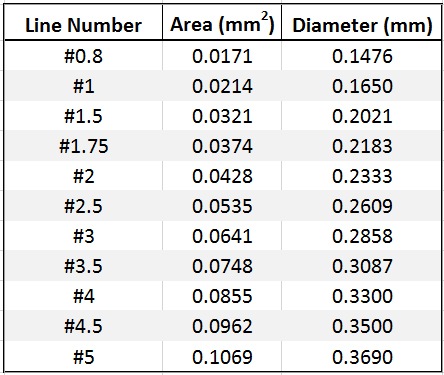
Now, the only slight caveat is that, just like hook sizes, manufacturers can vary a bit from the strictly calculated numbers.
Finally, on the subject of line-size, the numbering system does not take any account of the density of the material that a line is made from– only the area or diameter of that line. So #4 nylon is the same diameter as #4 fluorocarbon…but fluorocarbon is much denser.
In other words, #4 fluorocarbon line is much heavier than a #4 nylon line.
Storing Level Tenkara Lines
Just do me a favour though would you? Store and use your level lines on circular spools please? That way, nobody has to suffer the crinkly casting line and the reduced accuracy and range you get by wrapping it on any system that puts hairpin bends into each coil. While EZ-keepers or other “hairpin bend-inducing” line storage are OK for many braid or furled lines, it’s not a good idea with level line (or even factory-tapered nylon lines).
If you find yourself saying “I’ve never had a problem with EZ-keepers and level line”, I have to be honest and say that is because you can’t be paying enough attention to the detail of your casting.
While you can stretch out a lot of the kinks, you never completely get rid of them in the same way you can from a circular spool…And over the full length of a casting line, that ever-so-subtle zig-zag/rebound effect just sucks some of the energy out of your cast and pulls back your casting loop.
Summary
- Stored on circular spools and given a quick stretch before use – fluorocarbon level lines kick ass across a wide range of conditions…End of…
- In finer diameters (say #3 and below) you get great casting with low drape Otsuri. For bigger rivers, high winds, big flies and long lines, #3.5 and up will see you right. Plus you’ve a choice of colours from drab stealth through to hi viz.
Ultra-specialised Tenkara Lines – #3 Level Nylon
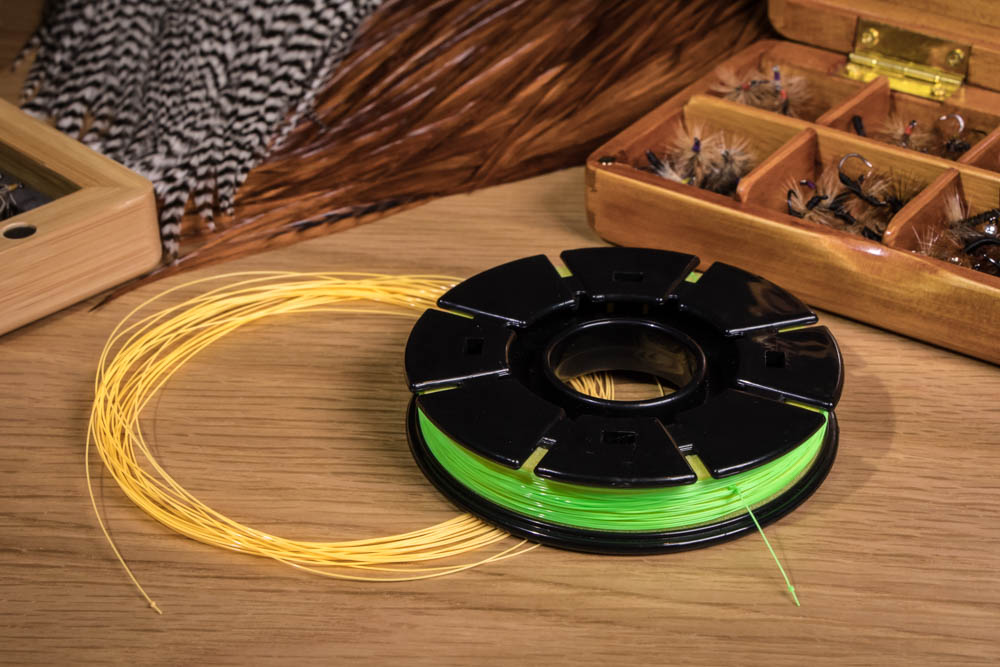
I know folks have experimented and used various sea-fishing (or backing line) nylon for tenkara for as long as there has been tenkara and nylon line. Some of that experimentation obviously ended up with the furled nylon lines that feature earlier in this guide.
For single filament lines, though, most of these experiments would end up with lines that were shorter than the rod which just “unrolled” down onto the water (mostly just by gravity). For any of the lines that were “cast”, most of these would be of diameters around #4 and #5 on the Japanese scale.
Looking for a cheap alternative to fluorocarbon level line on the one hand – versus looking for a specific, slower speed of fly delivery AND a dramatically reduced influence on the drift path and speed of a kebari on the other – are two WILDLY different things.
In fact, this is yet another perfect case for what is rapidly becoming my favourite quote from Oliver Wendell Holmes:
“I would not give a fig for the simplicity this side of complexity, but I would give my life for the simplicity on the other side of complexity“
In other words, the development process performed by Kazuo Kurahashi in search of the ultimate light level line material included many more factors than just price (although that was in there too!). He knew EXACTLY what properties he was looking for…and he spent a lot of time (and not inconsiderable amounts of money) trying out many different brands of both fluorocarbon and nylon.
That was a complex investigation.
He ended up throwing out the majority of those lines that he tried – and this is why the one line he finished up with counts as “The other side of complexity”.
What Kura-san – and his close-knit group of elite tenkara angler friends – settled on was a very specific combination of qualities. A particular brand of lime green nylon of #3 diameter had exactly what they needed…(and we also discovered it is available in peach too, which is less useful against most Japanese river backgrounds, but can be quite good in other countries, depending on the geology and vegetation).
Any other diameter of line did not work as well as alternatives in fluorocarbon. And any other texture, density or stiffness properties found in other nylon lines of the same diameter did not work as well as this brand of #3 nylon.
But this is where I tell you, in all honesty, that it is an uber-specialised tool. It is not for everyone. It certainly isn’t what you want to learn to cast with. Oh, and it is useless in anything more than a light breeze. So why the hell bother with it at all?
Well, if you can put in the time to learn to cast it (and it is HARD to cast – even with one of the few high-end rods that are up to the job), there are unique perks for anyone who masters it.
Probably the lowest amount of drape otsuri of any tenkara line is the most obvious benefit. On top of that, the turnover of level #3 nylon is slower and softer than the faster “zing” of fluorocarbon. For the most difficult fish on highly pressured rivers, those refinements make a huge difference. That is the simplest explanation of why it is worth having that tool in your pocket…but we need another article to explore those details properly.
For now, you can bookmark this page if you need a quick reference for any of the info – but most of all – if you learned Even One useful thing; please share this article with your tenkara friends (you can use the social media share buttons below, thank you).
As well as appreciating the info, folks will clearly also be able to see what a guru of fishing knowledge you are now (and what high quality content you are known for sharing)!
Paul & John.
PS – Want more kick-ass instruction and info?
